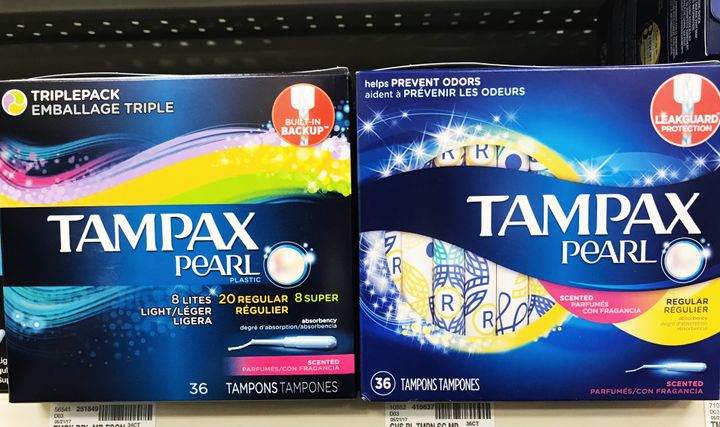
Let’s play pretend for a minute.
Imagine you pick up a box of crackers at the store. And under ingredients it just lists: “food.”
You’d have some questions, right?
Is it human food? Dog food? Rat food? Is it old food? New food? Rotten food? Does food mean just one single food? Or a whole bunch of food? Is it GMO food? Is it gluten food? Is it whole food? Processed food? Is it food I’m allergic to? Is it food that might give me hives? Is it cancer-causing food? Is it actually food at all?
Then imagine you called the cracker company and said, “I noticed the ingredients on your cracker box just lists ‘food’. I was hoping you could tell me what’s in the ‘food’, so I can decide if it’s safe for me to eat.”
And imagine they replied, “We don’t disclose food ingredient information. It’s proprietary.”
______
“Power over periods.”
That’s one of the latest taglines for P&G’s Tampax tampons. A supposed rallying cry for girls to take charge of their periods, their bodies, their lives.
Or you can read it as I do — as a statement from the company. The one who holds their corporate power over the girls who bleed.
______
I recently walked down the feminine care aisle at CVS and was overwhelmed by the number of scented products. I didn’t realize these things were still being sold. I could smell the perfume of Tampax Pearl regular absorbency tampons from outside the box. I picked it up to look at the label. I had to wash my hands when I got home to get rid of the horrible lingering floral scent.
I called Procter and Gamble’s customer service number this afternoon.
I said, “I noticed the ingredients on your Tampax Pearl Tampons lists ‘fragrance’. I was hoping you could tell me what’s in the ‘fragrance’, so I can understand if it’s safe.”
The women on the other end of the line put me on hold for a minute and came back with some information.
“I have the full ingredient list in front of me, and it just lists ‘fragrance.’ When they don’t list specifics, it means it’s proprietary information. I can’t give that out — it’s actually not even listed for me to give.”
I asked, “Is there another call I can make? Any way for me to see what’s in the fragrance?”
“No. Proprietary means companies don't give it out because its such a competitive field.”
“If you can’t give the exact ingredients, are you able to give any safety testing information?”
“I know some products need safety data sheet, some do not,” she said as she read me the URL for P&G’s safety sheet database. “You can take a peak and see if theres anything there.”
I searched the database several times, just to be sure. Each time, the results showed the same thing: no safety data sheets for any Tampax products.
______
Since P&G won’t disclose their specifics, let’s talk broadly about “fragrance.”
“Fragrance” is perhaps the greatest labeling loophole of all time.
It’s a catchall ingredient listing. Hidden behind that single, sexy word can be hundreds of combinations of synthetic chemicals — none of which companies are required to disclose, none of which companies are required to test for safety.

How do companies like P&G get away with it? Trade Secret protection. Which means fragrance information is allowed to remain proprietary on the grounds that disclosing the details would put them at a competitive disadvantage. Because of this, fragrance remains exempt from regulation by the FDA or Consumer Products Commission. Because of this, consumers suffer.
The list of chemicals used in fragrances is unthinkably long. The International Fragrance Association (a self-governing group, led by those who represent the companies producing the fragrances) released a self-selected list of 3,000 commonly used ingredients — Women’s Voices found that more than 1,000 of those ingredients appear on lists of hazardous chemicals. Many are known allergens and irritants. Others are recognized by the World Health Organization as known carcinogens.
Did you know your vagina is one of the most absorbent parts of your body?
A large percentage of the chemicals used in fragrances are classified as Phalates. Phalates are members of a long list of manmade chemicals known as EDCs, or Endocrine Disruptors. These are chemicals that mimic our real hormones and consquently disrupt the activity of signaling hormones. Given the widespread use of pthalates in consumer products and artifical fragrances, The WHO warns EDCs are a real health threat on multiple levels.
You know what organ is particularly sensitive to disruption?
The ovaries.
You know, the producers and releasers of eggs during monthly ovulation. The organ that is also an endocrine gland — responsible for producing estrogen and progesterone. The organ that allows us to create new life while also hormonally regulating the one we’re currently living.
So it should come as little surprise that, “limited studies in human populations suggest an association between phthalate exposure and adverse reproductive health outcomes.” And, “higher urinary phthalate levels correlated with pregnancy complications such as anemia, toxemia, and preeclampsia.”
______
P&G’s Tampax is currently the number one tampon brand in the US (Always, also owned by P&G, is the number one feminine care brand globally). And under these brand names, the company is selling products with undisclosed, unregulated, untested ingredients.
They’re selling these products to thirteen year old girls.
We live in a culture that remains reluctant to acknowledge the power of a woman’s capable, bleeding body. A culture that has long preferred we cover it up, hide, pretend. A culture that continues to insult and degrade women for what their bodies were designed to do.
The feminine care industry — an industry that should presumably have women’s best interests in mind — has only perpetuated the stigma. Using sterile blue liquid as a stand in for what’s actually red and rich, and feeding into the long-held, absolutely outrageous belief that real menstruation is dirty, smelly, unclean.
They’re preying on deep-seated insecurities. Shamelessly selling young girls chemically-perfumed, untested wads of bleached cotton and rayon from who-knows-where to push into the most absorbent, sensitive part of their body to mask their “odor.”
It’s marketing at its most repulsive. It’s absolutely unacceptable.
Yesterday, a group of change-making women marched on Washington, calling for feminine care manufacturers to disclose their ingredients.
But politics are slow and these companies are powerful. So while we wait for bills to pass, we can all help the cause by starting to vote with our dollars.
Join me in refusing to buy feminine care products from companies like P&G. Join me in supporting brands who disclose ingredients and make products that actually support vaginal health.
LOLA, Sustain Natural, THINX are current favorites.
